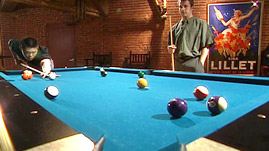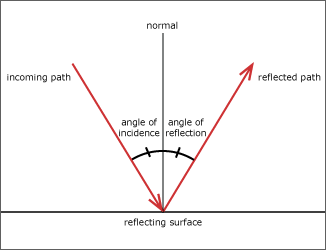Teachers' Domain - Digital Media for the Classroom and Professional Development
User: Preview

Source: Learning Math: Measurement: "The Angle on Pool"
In this video segment adapted from Annenberg Learner’s Learning Math: Measurement, learn how players think about angles in the game of pool. See how you can plan ahead for the next shot by controlling the angle at which the cue ball bounces off the target ball. Discover how when the cue ball travels without spin, its rebound path is always perpendicular to the path of the target ball. See how a player can change the angle to be more or less than 90 degrees by hitting the cue ball with reverse or forward spin. In addition, learn how the law of reflection predicts the path of a bank shot (when a ball is purposely bounced off the rail): the angle of incidence of the ball will be equal to the angle of reflection after it bounces off the rail.
Pool, or pocket billiards, is a game of mathematics and physics. The basic goal of play is to deposit balls into the pockets by hitting them with the cue ball. How the player strikes the cue ball (how hard, where, and in which direction) determines how the cue ball will interact with the other balls. The player can also purposely hit a ball into a rail of the table to have the ball bounce off and travel in a particular direction; this is called a bank shot. A skilled player understands how to control the path of the balls.
When playing pool, an important concept to understand is the symmetry of angles, as governed by the law of reflection. The law of reflection states that the angle of incidence—the angle formed by the path of the incoming object and the normal line (the perpendicular line) to the reflecting surface—is equal to the angle of reflection—the angle formed by the normal to the surface and the path of the object as it leaves the surface. According to the law of reflection, the angle at which an object hits a flat surface will be equal to the angle at which it bounces off the surface.

Assuming there is no spin on a pool ball and conditions are ideal (for example, the balls are perfectly round and the surface of the table is perfectly flat and frictionless), the angle at which a ball hits the rail of the table will be equal to the angle at which it rebounds. The symmetry of incident and reflected angles can be used to predict the behavior of pool balls as well as other things, such as how light bounces off a mirror or how sound bounces off walls.
In the game of pool, it is also important to consider the angle at which the cue ball rebounds off the target ball. Again, assuming ideal conditions and no spin on the cue ball, the cue ball will always rebound at 90 degrees from the path of the target ball (unless the collision is head-on). This "90-degree rule" is a result of physics—because momentum is conserved, after the collision, the cue ball must move in a direction that is perpendicular to the motion of the other ball.
Hitting the cue ball below or above its center will cause it to spin, which affects the angle at which it will rebound. By manipulating the spin of the cue ball, you can alter its rebound path to set it up for another good shot.
Connections to the Common Core State Standards
High School: Geometry
Grade 8
After the video
 Loading Standards
Loading Standards